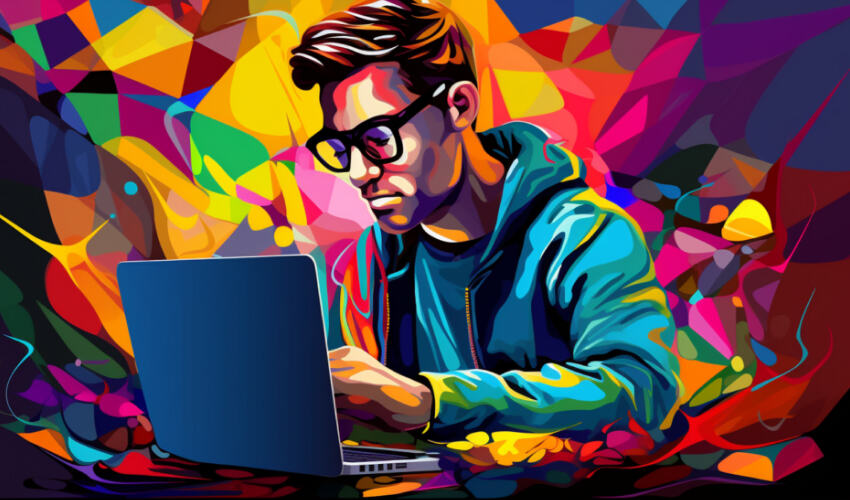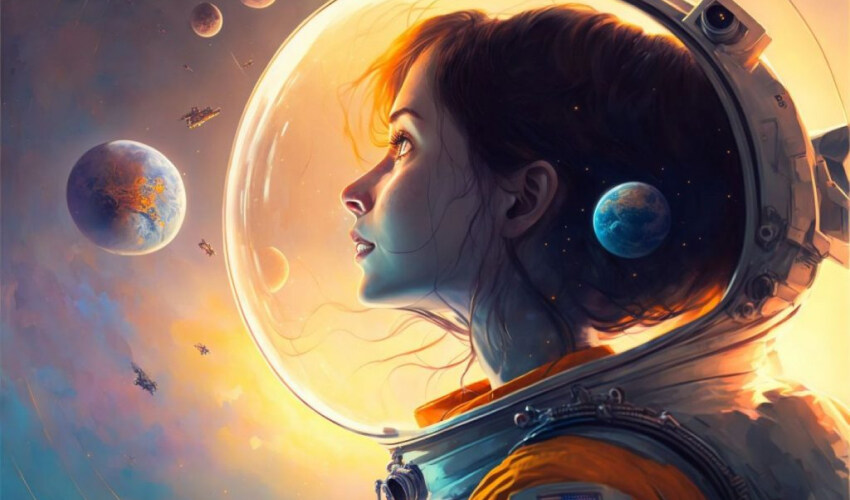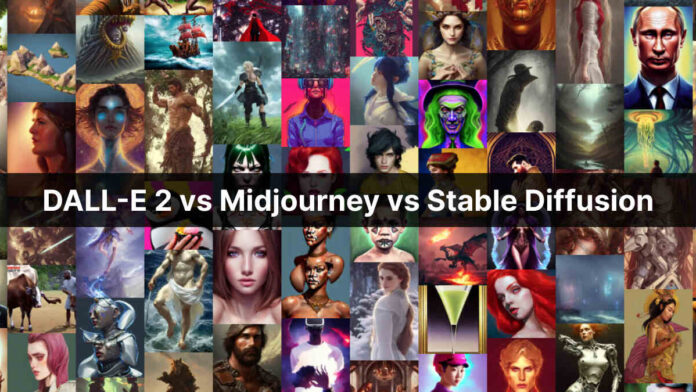AI image generation is a revolutionary field that utilizes artificial intelligence to create realistic and imaginative visual content. This blog delves into three cutting-edge models: DALL-E 2 Vs Midjourney Vs Stable Diffusion. We aim to provide an in-depth comparative analysis of these advanced AI models, exploring their unique features, strengths, and limitations. Understanding these models is crucial as they hold immense potential for diverse applications.
From generating lifelike artwork and creating custom designs to aiding in virtual simulations and enhancing content creation, advanced AI image generation opens new avenues for industries and unleashes unparalleled creativity. Embracing this technology responsibly can lead to transformative advancements in various fields.
What is DALL-E 2?
DALL-E 2 is an advanced AI image generation model developed by OpenAI, building on its predecessor, DALL-E. Operating on a transformer-based architecture, DALL-E 2 excels at generating high-quality images from textual prompts. With its vast dataset and impressive computational power, the model can produce diverse and coherent visual representations based on natural language descriptions.
Using this technology, we can revolutionize the content creation, design, and entertainment industries, offering novel artistic possibilities. However, it raises ethical concerns about responsible AI use and potential misuse, necessitating scrutiny and guidelines to ensure its positive impact on society.
DALL-E 2 Features
1. Enhanced Image Generation
DALL-E 2 significantly improved over its predecessor, generating even higher-quality images from textual prompts with greater detail and realism.
2. Expanded Creativity
This version of DALL-E demonstrates enhanced creativity, producing more imaginative and surreal outputs, pushing the boundaries of what AI can achieve in artistic expression.
3. Improved Control
Users have better control over the generated images, allowing for fine-tuning of specific features and attributes, resulting in more personalized and customized outputs.
4. Robustness and Stability
DALL-E 2 exhibits improved stability during image generation, reducing the likelihood of producing distorted or nonsensical results, leading to more reliable outputs.
5. Faster Processing
The model’s efficiency and processing speed have been optimized, enabling quicker generation of images, making it more practical for real-time applications.
6. Larger and Diverse Dataset
DALL-E 2 benefits from a more extensive and diverse dataset, encompassing a more comprehensive range of visual concepts, leading to a better understanding of complex textual prompts.
7. Seamless Object Integration
The model excels at integrating multiple objects within an image, creating visually coherent scenes, and improving overall image composition.
8. Realistic Text-to-Image Translation
DALL-E 2 can translate highly abstract textual descriptions into vivid and plausible images, demonstrating significant progress in natural language understanding.
9. Ethical Considerations
With increased image realism and creative potential, DALL-E 2 raises ethical concerns regarding responsible use and potential misuse, emphasizing ethical guidelines in AI image generation.
DALL-E 2 Pros and Cons
DALL-E 2 Pros
▶ High-Quality Image Generation: DALL-E 2 excels in producing visually stunning and high-resolution images, often indistinguishable from human-created artwork.
▶ Enhanced Creativity: The model showcases remarkable creativity, generating imaginative and surreal images pushing traditional AI-generated art’s boundaries.
▶ Improved Control: Users have more fine-grained control over the generated images, allowing for specific customization and manipulation of visual elements.
▶ Faster Processing: DALL-E 2’s optimized architecture enables more rapid image generation, making it more efficient for real-time applications and content creation.
▶ Seamless Object Integration: The model effectively integrates multiple objects into a single image, resulting in visually coherent and realistic scenes.
▶ Robustness: DALL-E 2 demonstrates increased stability during image generation, reducing the occurrence of distorted or nonsensical outputs.
DALL-E 2 Cons
▶ Computationally Intensive: DALL-E 2 requires substantial computational resources and time for training and image generation due to its complexity.
▶ Data Dependence: The model heavily relies on the quality and diversity of the training dataset, potentially leading to biased or limited outputs.
▶ Ethical Concerns: DALL-E 2’s ability to generate highly realistic images raises ethical concerns regarding potential misuse, such as creating deep fakes or false information.
▶ Interpretability Challenges: Like many deep learning models, DALL-E 2’s decision-making process needs more transparency, making its outputs challenging to understand.
▶ Overfitting: In some cases, DALL-E 2 might produce images closely resembling those from its training data, limiting its generalization to entirely new and unseen concepts.
▶ Environmental Impact: The computational demands of DALL-E 2 contribute to increased energy consumption, raising concerns about its environmental footprint.
What is Midjourney?
Midjourney is an ingenious AI image generation model that has garnered significant attention in artificial intelligence. Developed by a team of researchers, Midjourney takes advantage of Generative Adversarial Networks (GANs) to create stunning and lifelike images from textual descriptions.
Unlike traditional text-to-image models, Midjourney employs a two-step process, which involves creating rough sketches based on the given text and refining them to produce detailed and polished images. This unique approach allows the model to generate diverse and coherent visuals, showcasing its versatility and potential applications in creative design, virtual simulations, and content generation for various industries.
Midjourney features

Source: TechFinitive
● GAN-Based Architecture: Midjourney utilizes Generative Adversarial Networks (GANs), a powerful deep learning technique, to generate images from textual prompts.
● Two-Step Image Generation: Unlike traditional text-to-image models, Midjourney employs a two-step process. It first creates rough sketches based on the input text and then refines them to produce detailed and realistic images.
● Improved Image Realism: Midjourney generates highly realistic images, captures intricate details and textures, and makes the output visually appealing and authentic.
● Text-Guided Generation: The model interprets and understands textual descriptions, allowing users to control the generated images’ content, style, and composition through simple text prompts.
● Coherent and Contextual Outputs: Midjourney excels in producing coherent images that align with the input text, ensuring the generated visuals make sense and are contextually relevant.
● Fine-Grained Control: Users can tweak various aspects of the generated images, such as object placement, colors, and other attributes, providing greater customization.
● Creative Versatility: Midjourney’s two-step generation process results in diverse and imaginative outputs, showcasing its ability to produce unique artwork styles and perspectives.
● Potential Applications: This versatile AI model finds applications in multiple domains, including creative design, content creation, virtual simulations, and more, empowering various industries with novel image generation capabilities.
● Ethical Considerations: As with any advanced AI image generation model, ethical considerations arise concerning responsible usage, potential bias in training data, and preventing misuse of the generated content.
Midjourney Pros and Cons
Midjourney Pros
▶ Realistic Image Generation: Midjourney generates highly realistic and detailed images, making it suitable for applications requiring lifelike visuals.
▶ Two-Step Process: The two-step generation approach of Midjourney allows for more control and refinement, resulting in coherent and contextually relevant image outputs.
▶ Text-Guided Customization: Users can easily guide the model’s image generation process through simple text prompts, enabling fine-grained control and customizing the generated visuals.
▶ Creative Versatility: The model’s ability to produce diverse and imaginative outputs makes it a valuable tool for innovative design, art, and multimedia content creation.
▶ Versatility in Applications: Midjourney’s capabilities find applications in gaming, virtual simulations, advertising, and graphic design, enhancing content creation and visual storytelling.
Midjourney Cons
▶ Computational Complexity: The two-step process and GAN-based architecture of Midjourney can be computationally intensive, requiring significant training and image generation resources.
▶ Training Data Dependency: The model’s outputs are heavily influenced by the quality and variety of the training data, potentially leading to biases or limitations in the generated outputs.
▶ Ethical Concerns: As with any AI image generation model, Midjourney raises ethical concerns regarding responsible use, potential misuse, and creating deepfakes or false information.
▶ Interpretability Challenges: Understanding the decision-making process of Midjourney can be challenging due to the complexity of GANs, making it difficult to explain how specific outputs are generated.
▶ Overfitting: There may be instances where Midjourney produces images closely resembling training data, limiting its ability to generalize to entirely new and unseen concepts.
What is Stable Diffusion?

Source: Metaverse Post
Stable Diffusion is an advanced AI image-generation technique that has gained significant attention in research. Developed as an alternative to traditional Generative Adversarial Networks (GANs), Stable Diffusion utilizes a diffusion process to generate high-quality images. Unlike GANs, which employ a generator-discriminator setup, Stable Diffusion relies on iterative steps to progressively refine random noise into coherent ideas.
This approach ensures excellent stability during generation and mitigates issues like mode collapse commonly associated with GANs. Stable Diffusion has shown remarkable success in generating realistic and diverse images, offering a promising direction for AI image synthesis with improved reliability and efficiency.
Stable Diffusion features
● Diffusion-Based Generation: Stable Diffusion employs a diffusion process to generate images, where a series of iterative steps refine random noise into coherent visuals.
● Progressive Refinement: Unlike traditional GANs, Stable Diffusion progressively improves the generated image at each step, ensuring excellent stability and mitigating issues like mode collapse.
● Improved Image Quality: The diffusion process allows for high-quality image generation with realistic details, resulting in visually appealing and authentic outputs.
● Diversity in Outputs: Stable Diffusion can produce diverse and varied images, capturing different modes of data distribution, leading to a broader range of generated content.
● Enhanced Stability: The model’s diffusion-based approach offers improved stability during image generation, making it less prone to producing distorted or implausible results.
● Efficient Training: Stable Diffusion is computationally efficient, requiring less training time and resources than traditional GANs.
● Robust Performance: The diffusion-based technique demonstrates strong performance across various datasets and image resolutions, indicating its versatility and reliability.
● Broad Applicability: Stable Diffusion’s success in generating high-quality images makes it valuable in content creation, art, and design, as well as in applications involving visual simulations and virtual environments.
Stable Diffusion Pros and Cons
Stable Diffusion Pros
▶ Stable Image Generation: As the name suggests, Stable Diffusion offers improved stability during image generation, reducing the risk of generating distorted or unrealistic outputs.
▶ High-Quality Images: The diffusion-based approach enables Stable Diffusion to produce high-quality images with intricate details, making it suitable for applications requiring realistic visuals.
▶ Diverse Outputs: Stable Diffusion can generate diverse and varied images, capturing different modes of data distribution and providing a broader range of creative possibilities.
▶ Efficient Training: Compared to traditional GANs, Stable Diffusion has demonstrated greater efficiency in training, requiring less computational resources and time.
▶ Mode Collapse Mitigation: The progressive refinement of Stable Diffusion helps mitigate mode collapse issues commonly associated with GANs, ensuring a more reliable and diverse image synthesis.
Stable Diffusion Cons
▶ Complex Implementation: Implementing Stable Diffusion may require a deeper understanding of the diffusion process, making it more challenging for some researchers and developers.
▶ Interpretability Challenges: Like many advanced AI models, Stable Diffusion’s decision-making process needs more transparency, making interpreting how specific images are generated difficult.
▶ Data Dependence: Stable Diffusion’s performance depends on the training data’s quality and diversity, potentially leading to biases or limitations in the generated outputs.
▶ Limited Fine-Grained Control: While Stable Diffusion can produce diverse images, it may offer limited fine-grained control over specific attributes of the generated visuals.
▶ Environmental Impact: Despite its training efficiency, Stable Diffusion requires substantial computational power, contributing to increased energy consumption and environmental impact.
DALL-E 2 Vs. Midjourney Vs. Stable Diffusion comparison
Image Quality
▶ DALL-E 2: Known for producing high-quality and realistic images, often indistinguishable from human-created art.
▶ Midjourney: Offers competitive image quality, generating visually coherent and contextually relevant outputs.
▶ Stable Diffusion: Strives for high image quality with intricate details, resulting in visually appealing and authentic visuals.
Creativity
▶ DALL-E 2: Showcases impressive creativity, generating surreal and imaginative artwork, pushing the boundaries of AI-generated art.
▶ Midjourney: Offers versatility in creative design, capable of producing diverse outputs with unique artistic styles.
▶ Stable Diffusion: Strikes a balance between realism and artistic expression, providing visually appealing outputs with fine details.
Features
▶ DALL-E 2: Utilizes a transformer-based architecture, enabling it to process complex textual prompts and generate corresponding images.
▶ Midjourney: Leverages Generative Adversarial Networks (GANs) and a two-step image generation process for improved stability and refinement.
▶ Stable Diffusion: Relies on a diffusion process to progressively refine random noise into coherent images, mitigating mode collapse issues.
Fine-Grained Control
▶ DALL-E 2: Offers limited fine-grained control over specific attributes of generated visuals.
▶ Midjourney: Provides better control and customization through text-guided image generation.
▶ Stable Diffusion: Allows progressive refinement, enabling some control over the generated images.
Diversity
▶ DALL-E 2: Can generate diverse images, especially regarding artistic styles and visual concepts.
▶ Midjourney: Demonstrates competitive diversity, capturing different modes of data distribution and offering varied image outputs.
▶ Stable Diffusion: Provides a broader range of creative possibilities with diverse and varied image generation.
Efficiency
▶ DALL-E 2: Efficient in generating images but requires a large amount of computing power to train.
▶ Midjourney: Offers faster training times and requires fewer computational resources than traditional GANs.
▶ Stable Diffusion: Demonstrates training efficiency, requiring less time and resources than other image generation models.
Applications
▶ DALL-E 2: Valuable in art, design, and multimedia content creation, inspiring new forms of visual expression.
▶ Midjourney: Useful in creative design, virtual simulations, and content generation across various industries.
▶ Stable Diffusion: Applicable in gaming, advertising, and virtual environments, enhancing visual storytelling and content creation.
DALL-E 2 vs. Midjourney vs. Stable Discussion: Which is Better
Determining which model, DALL-E 2, Midjourney, or Stable Diffusion, is better depends on the specific context and requirements. Each model possesses unique strengths and capabilities, catering to different use cases.
DALL-E 2 excels in producing high-quality, realistic, imaginative artwork, making it ideal for creative design and art-related applications. Its transformer-based architecture allows it to understand complex textual prompts, resulting in visually appealing outputs.
Midjourney stands out for its stability, text-guided customization, and coherent image generation. It is well-suited for applications that require controlled customization and contextually relevant visuals, making it valuable in creative design, virtual simulations, and content generation.
Stable Diffusion’s diffusion-based approach offers a balance between realism and creativity. It efficiently generates diverse and high-quality images, making gaming, advertising, and visual helpful storytelling.
Ultimately, the “better” model depends on a project or application’s specific needs and goals. Researchers and developers should carefully assess each model’s features and performance metrics to determine which aligns best with their requirements.
Also See: Top 5 Dall-E 2 Alternatives: The Best AI Art Generators of 2023
In conclusion, the trio of DALL-E 2, Midjourney, and Stable Diffusion showcase the impressive capabilities of AI image generation. DALL-E 2 dazzles with its surreal and realistic artwork, while Midjourney offers stability and controlled customization for creative design.
Stable Diffusion perfectly balances realism and creativity, generating diverse and visually appealing outputs. The best choice depends on the specific artistic vision and application needs. As these models evolve, they will undoubtedly revolutionize image generation, offering new avenues for human creativity and pushing the boundaries of what AI can achieve in visual art.


